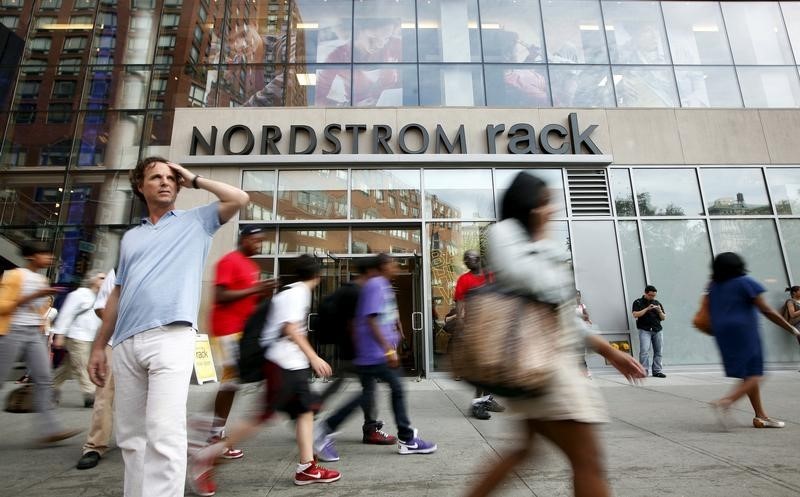Stock Story -
Luxury department store chain Nordstrom (NYSE:JWN) reported Q3 CY2024 results beating Wall Street’s revenue expectations, with sales up 4.3% year on year to $3.46 billion. Its non-GAAP profit of $0.33 per share was 50.2% above analysts’ consensus estimates.
Is now the time to buy Nordstrom? Find out by reading the original article on StockStory, it’s free.
Nordstrom (JWN) Q3 CY2024 Highlights:
- Revenue: $3.46 billion vs analyst estimates of $3.35 billion (4.3% year-on-year growth, 3.3% beat)
- Adjusted EPS: $0.33 vs analyst estimates of $0.22 (50.2% beat)
- Adjusted EBITDA: $231 million vs analyst estimates of $228.8 million (6.7% margin, 1% beat)
- Management reiterated its full-year Adjusted EPS guidance of $1.90 at the midpoint
- Operating Margin: 2.4%, in line with the same quarter last year
- Free Cash Flow was -$274 million compared to -$508 million in the same quarter last year
- Locations: 381 at quarter end, up from 360 in the same quarter last year
- Same-Store Sales rose 4% year on year (-3.9% in the same quarter last year) (beat)
- Market Capitalization: $4.09 billion
Company OverviewKnown for its exceptional customer service that features a ‘no questions asked’ return policy, Nordstrom (NYSE:JWN) is a high-end department store chain.
Department Store
Department stores emerged in the 19th century to provide customers with a wide variety of merchandise under one roof, offering a convenient and luxurious shopping experience. They played an important role in the history of American retail and urbanization, and prior to department stores, retailers tended to sell narrow specialty and niche items. But what was once new is now old, and department stores are somewhat considered a relic of the past. They are being attacked from multiple angles–stagnant foot traffic at malls where they’ve served as anchors; more nimble off-price and fast-fashion retailers; and e-commerce-first competitors not burdened by large physical footprints.Sales Growth
A company’s long-term sales performance signals its overall quality. Even a bad business can shine for one or two quarters, but a top-tier one grows for years.Nordstrom is one of the larger companies in the consumer retail industry and benefits from a well-known brand that influences consumer purchasing decisions. However, its scale is a double-edged sword because there are only a finite number of places to build new stores, making it harder to find incremental growth.
As you can see below, Nordstrom struggled to increase demand as its $15.11 billion of sales for the trailing 12 months was close to its revenue five years ago (we compare to 2019 to normalize for COVID-19 impacts). This was surprising given it opened new stores, implying its underperformance was driven by lower sales at existing, established locations.
This quarter, Nordstrom reported modest year-on-year revenue growth of 4.3% but beat Wall Street’s estimates by 3.3%.
Looking ahead, sell-side analysts expect revenue to remain flat over the next 12 months. This projection is underwhelming and suggests its newer products will not accelerate its top-line performance yet.
Today’s young investors won’t have read the timeless lessons in Gorilla Game: Picking Winners In High Technology because it was written more than 20 years ago when Microsoft (NASDAQ:MSFT) and Apple (NASDAQ:AAPL) were first establishing their supremacy. But if we apply the same principles, then enterprise software stocks leveraging their own generative AI capabilities may well be the Gorillas of the future. So, in that spirit, we are excited to present our Special Free Report on .
Store Performance
Number of StoresThe number of stores a retailer operates is a critical driver of how quickly company-level sales can grow.Nordstrom operated 381 locations in the latest quarter. It has opened new stores quickly over the last two years and averaged 1.7% annual growth, faster than the broader consumer retail sector.
When a retailer opens new stores, it usually means it’s investing for growth because demand is greater than supply, especially in areas where consumers may not have a store within reasonable driving distance.
Same-Store SalesThe change in a company's store base only tells one side of the story. The other is the performance of its existing locations and e-commerce sales, which informs management teams whether they should expand or downsize their physical footprints. Same-store sales provides a deeper understanding of this issue because it measures organic growth at brick-and-mortar shops for at least a year.
Nordstrom’s demand has been shrinking over the last two years as its same-store sales have averaged 1.2% annual declines. This performance is concerning - it shows Nordstrom artificially boosts its revenue by building new stores. We’d like to see a company’s same-store sales rise before it takes on the costly, capital-intensive endeavor of expanding its store base.
In the latest quarter, Nordstrom’s same-store sales rose 4% year on year. This growth was a well-appreciated turnaround from its historical levels, showing the business is regaining momentum.
